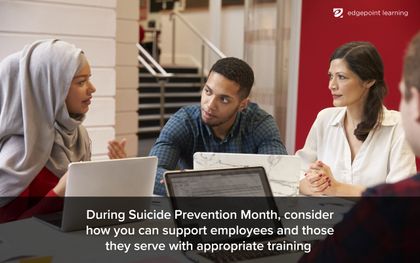How To Develop Effective Suicide Prevention Training
Michelle Moorhead
🍿 5 min. read
If you have not considered suicide prevention training in the past, think about it now during National Suicide Prevention Month
September is National Suicide Prevention Month. You might not think that suicide prevention training is something that you need in your field of work, but suicide prevention is everyone’s business. While there are many factors that are associated with suicide, prevention begins with a conversation. With that in mind, gatekeeper training programs have been at the front lines of preventing suicide for many years. In fact, gatekeepers are used in a variety of settings including healthcare, community work, education, law enforcement, and business.
Gatekeepers are not behavioral health experts, but rather caring individuals, often natural helpers, who can talk to a person about their thoughts of suicide and hand them off to a trained professional. If you are thinking about starting a gatekeeper training program, please work with your local suicide prevention organization or crisis provider.
What is suicide prevention training?
Gatekeeper training programs focus on increasing knowledge, attitudes, and skills to recognize and respond to suicide risk. The training helps the gatekeeper assist a person who may be at risk for suicide and is able to facilitate contact with appropriate referrals for help. Suicide prevention training works to help people recognize risk factors for suicide and to take steps to help those in need. Although there is lingering stigma about discussing many aspects of mental health, suicide prevention training is crucial in saving lives.
Consider these stats.
- Death by suicide has risen 24% in the past 15 years
- The increase has occurred across all genders, races, and age groups
- Girls between 10 and 14 years of age have seen a 200% increase (suicide is the third leading cause of death in this age group)
- Men in all age groups are four times as likely to die by suicide
The U.S. Centers for Disease Control (CDC) agrees that prevention is key to reducing the rate of suicide. This means providing suicide prevention training to people throughout the community to serve as gatekeepers to help. Gatekeepers are people who might have direct contact with people who are most at risk of suicide. Examples of gatekeepers include educators, human resources directors, and managers, all who might notice changes in someone’s behavior or engagement. In some cases, even a trusted co-worker can be in a position to recognize at-risk behavior and offer support. Gatekeepers could be anyone who is interested in and willing to help.

Which topics should I cover in our suicide prevention training?
Suicide prevention training can be conducted in-person or online. It is important to work with someone who understands suicide prevention when developing a program. Regardless of how it is delivered, there are some common elements, or topics, to discuss in each training. You can also supplement it with mental health training, which is covered in an earlier post.
Please consider working with someone trained in suicide prevention to help identify which type of gatekeeper training is best for your business. In addition, Edgepoint Learning has the expertise to develop this type of program and has helped Teen Lifeline implement several eLearning programs.
It is also important to remember that a gatekeeper does not provide behavioral health services, such as counseling, but rather helps to identify those who might be at risk and connects them with a higher level of care. Note that some professionals will have additional, intensive training on key topics.
Demystifying suicide
One of the main reasons people who are suffering do not seek help is due to a lingering stigma surrounding suicide.
A suicide prevention training can help to dispel myths about suicide and suicide prevention. This process can help those in the training to understand why someone might be reluctant to seek help and to take steps to draw them out. In addition, this training can help reduce stereotypes that may increase stigma.
Identifying risk factors
Gatekeeper training will help identify some of the risk factors for suicide. Some of these include:
- Previous suicide attempts
- A family history of suicide or mental disorders
- History of drug and alcohol use/abuse
- Access to lethal weapons
- Traumatic life experiences
- Social isolation
Not everyone who has the above risk factors will consider suicide. Suicide prevention training helps gatekeepers recognize the difference between when someone is struggling with “normal” stressors and those who may be at risk for suicide.
Noticing warning signs
The warning signs of suicide may seem much clearer after the fact. Suicide prevention training, though, clarifies behavior that indicate a person could be moving towards action.
Warning signs might include a loss of interest, personality changes, and giving away important possessions (among others).
You can learn more of the warning signs at SAVE.
Structuring language
People who are reluctant to discuss suicide with an at-risk person may be worried about saying the “wrong thing.” They might be concerned that their words could be harmful. Suicide prevention training teaches how to have a conversation with an at-risk person in a way that is open and inviting (or at the very least neutral). Gatekeeper training helps people have that “scary” conversation about thoughts of suicide and provides the tools to help connect people at risk to help.
Positive conversation starters like, “I've been worried about you and wanted to check in,” or “How can I support you right now?” can go a long way to start a conversation that could save a person’s life.
Language is important in another way. The language we use when talking about suicide can be helpful, but it can also be harmful. Avoid certain phrases that stigmatize suicide, such as "committed suicide" as it positions the act as a crime, or suicide attempts as "successful" or "unsuccessful." Instead, opt for the term "died by suicide" in most cases.
The goal here is to be supportive of those who have lost a loved one to suicide and those who are vulnerable to suicide. For course developers, learn more of the guidelines for writing on suicide here.
Gathering resources
The National Suicide Prevention Line is a toll-free, 24/7 lifeline for people who need to talk to someone immediately. This number will instantly connect you to someone in your own community who can talk at any time of day or night, all across the nation.
In Arizona, Teen Lifeline offers phone or text support for teens, their parents, and community.
These hotlines are just one of the many types of resources that are available to people in distress. Many communities will have their own local hotlines or support resources. Suicide prevention training helps employees gather resources so they have them ready if needed.
Connecting to help
Arguably the hardest call to make is one that occurs in an emergency situation. This situation arises when it is clear that a person has the intent, the means, and the desire to take their life. In this case, gatekeepers are trained to recognize these signs and respond appropriately to get necessary help. In some instances, connecting the individual to immediate support is necessary. Gatekeepers will be trained on how to hand someone off to emergency services when needed.
Suicide prevention training also helps employees know when and how respond to situations that are not necessarily an emergency (but that still require support).
Learn more about suicide prevention training
Suicide prevention training is a critical part of keeping your employees safe.
To find out more about suicide and suicide prevention training and to gather resources, visit the websites below for more information:
- Teen Lifeline: https://teenlifeline.org
- National Suicide Prevention Lifeline: https://suicidepreventionlifeline.org
- Suicide Prevention Resource Center: https://www.sprc.org
- National Alliance on Mental Illness (NAMI): https://www.naminh.org
- American Foundation for Suicide Prevention (ASFP): https://afsp.org
